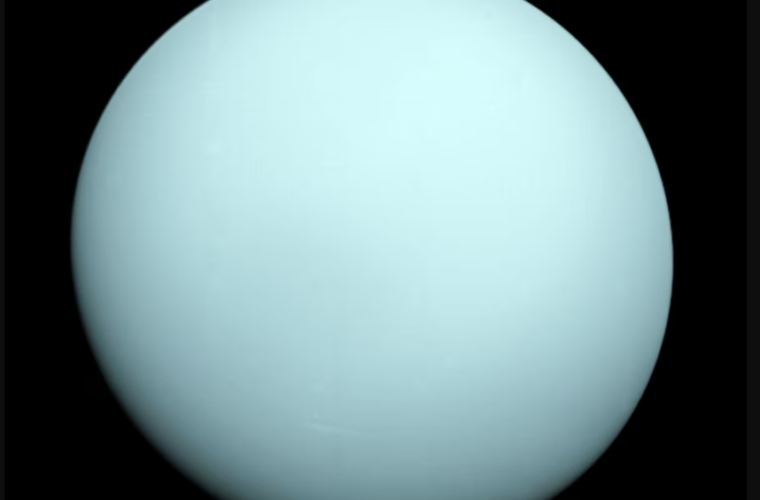-Ashley Strickland
Astronomers using the powerful eye of the James Webb Space Telescope have spotted a previously unknown moon whirling around Uranus, according to NASA. The discovery boosts the number of moons known to be orbiting the ice giant to 29 — and there are likely more waiting to be found.
The moon came to light through a series of 40-minute long-exposure images taken by Webb’s Near-Infrared Camera on February 2.
“It’s a small moon but a significant discovery, which is something that even NASA’s Voyager 2 spacecraft didn’t see during its flyby nearly 40 years ago,” said Maryame El Moutamid, a lead scientist in the Southwest Research Institute’s Solar System Science and Exploration Division in Boulder, Colorado, in a statement.
El Moutamid is the principal investigator of a Webb program dedicated to analyzing the structure and dynamics of the typically hidden rings and inner moons of Uranus.
The glow of Uranus’ rings and the moon’s tiny size, measuring about 6 miles (10 kilometers) in diameter, are likely what obscured it from the view of Voyager 2, the only mission that has performed flybys of Uranus and Neptune, as well as telescopes such as Hubble that have observed the solar system’s outer planets.
It’s possible that the moon and some of the material comprising Uranus’ rings have a common origin, which could mean the rings and moon are fragments resulting from the same ancient event, El Moutamid said.
The moon, temporarily named S/2025 U1, could reveal how Uranus’ rings are shaped, whether by gravity or an ancient event, to provide a window into the enigmatic rings’ structure, stability and history, she said.
“The discovery raises questions about how many more small moons remain hidden around Uranus and how they interact with its rings,” El Moutamid said.
Finding a tiny moon
The discovery of moons around planets in our solar system is not a very common occurrence, but it does happen from time around giant planets like Jupiter, Saturn, Uranus and Neptune.
“These planets have many moons, and some are so tiny and faint that we’re still discovering them,” El Moutamid said.
The newly found moon is the 14th in a system of small moons orbiting Uranus — all of which orbit closer to the planet than its largest moons: Miranda, Ariel, Umbriel, Titania and Oberon.
“It’s located about 35,000 miles (56,000 kilometers) from Uranus’ center, orbiting the planet’s equatorial plane between the orbits of Ophelia (which is just outside of Uranus’ main ring system) and Bianca,” El Moutamid said, referring to two other small moons circling the planet. “Its nearly circular orbit suggests it may have formed near its current location.”
Spotting the moon was no easy task because it is tiny, dark and moves quickly, which made it nearly invisible against the background glow of Uranus’ rings, El Moutamid said. The high resolution and sensitivity of Webb’s Near-Infrared Camera was perfectly suited to find a faint, distant object, she said.
Webb’s ability to capture infrared light, invisible to the human eye, has also provided glimpses of Uranus’ rings and moons, atmosphere and weather during earlier observations.
“Its detection highlights both the dynamic complexity of Uranus’s system and the sharp eyes of modern astronomy.”
Uranus’ icy moon Miranda is seen in this image from Voyager 2 on January 24, 1986.
Uranus’ icy moon Miranda is seen in this image from Voyager 2 on January 24, 1986. NASA/JPL-Caltech
So far, all of Uranus’ moons have been named for characters from the works of William Shakespeare and Alexander Pope.
The previously unknown moon doesn’t have a literary name yet, and the International Astronomical Union, which assigns official names to celestial objects, will need to approve one.
Part of the difficulty in determining just how many moons orbit Uranus is the proximity of these natural satellites to the planet and the bright glare of the planet itself, said Scott Sheppard, astronomer at the Carnegie Institution for Science in Washington, DC. Sheppard was not involved in the new observations but helped discover a Uranus moon in 2024.
“This new Uranus moon is a very exciting find since it is so close to Uranus and likely associated with the inner ring system,” Sheppard said. “This discovery shows the power of the James Webb Space Telescope to be able to image deeper than we ever have before.”
A growing collection of satellites
No other planet has as many small inner moons as Uranus, said coprincipal investigator Matthew Tiscareno, a senior research scientist of solar system dynamics and planetary rings at the SETI Institute in Mountain View, California. Astronomers don’t quite know how the diminutive moons have avoided crashing together because they’re so close to one another, but the satellites may act as shepherds for Uranus’ narrow rings, according to NASA.





